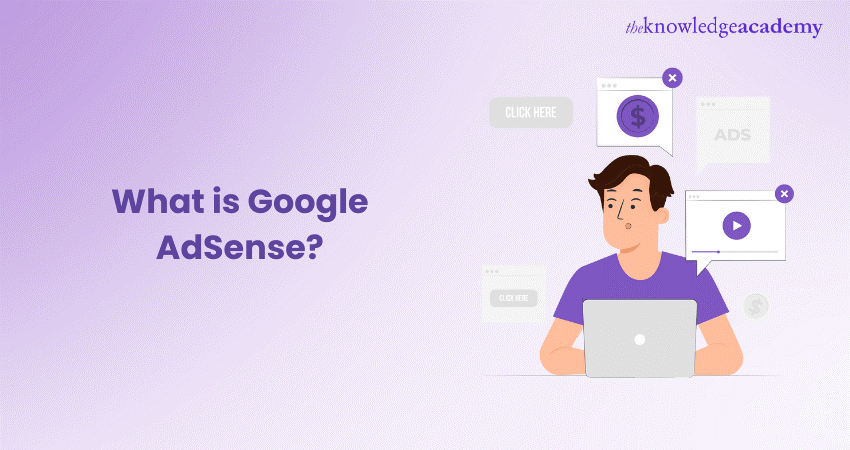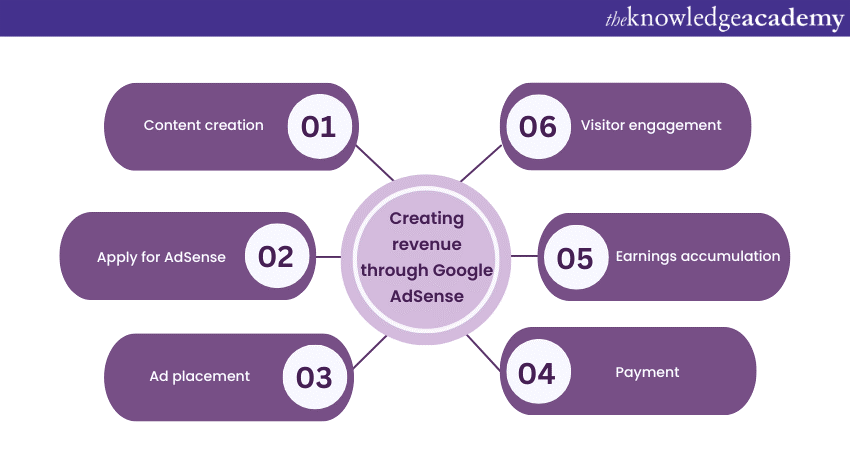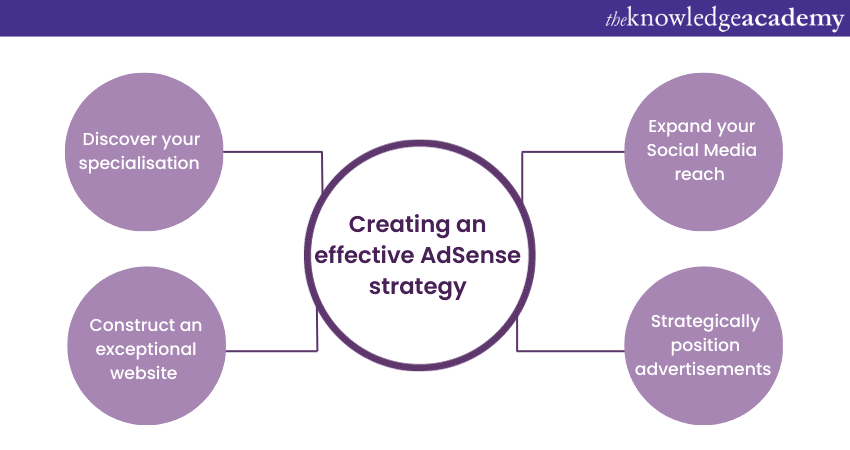We may not have the course you’re looking for. If you enquire or give us a call on +800 312616 and speak to our training experts, we may still be able to help with your training requirements.
Training Outcomes Within Your Budget!
We ensure quality, budget-alignment, and timely delivery by our expert instructors.

If you own a website or blog where you share content such as recipes, travel advice or workout routines, you have the opportunity to generate income with Google AdSense. It is a program by Google that helps people earn money from their websites or blogs. AdSense displays ads on your site, and you get paid when visitors click on those ads. This is a great way for beginners to earn income online.
To monetise your content, you need a dedicated audience. You can earn money when visitors click on them by allowing advertisers to display their ads on your site with Google AdSense. That's why it's important to understand what Google AdSense is and how it works.
If you want to learn more about Google AdSense, its types, advantages, and how it works, read our blog. You can start monetising your content today!
Table of Contents
1) What is Google AdSense?
2) How Does Google AdSense Work?
3) Types of Google AdSense Ads
4) Advantages of using AdSense
5) Conclusion
What is Google AdSense?
Google AdSense is a program that helps website owners and content creators make money by displaying ads on their websites or YouTube channels. AdSense is popular because it's a relatively simple way for people to monetise their online content.
It's especially beneficial for those who create blogs, videos, or other online content but don't want to sell their own products or services. Google handles the ad selection, placement, and payment process, making it a convenient way to generate income from your online efforts.

How Does Google AdSense Work?
Below are a few steps that tell you how Google AdSense works.
1) Register and prepare your website for ads
The first step is to register for Google AdSense. You must provide information about your website or YouTube channel, and Google will review your application. Once approved, you'll receive a unique code to place on your website or in your videos. This code allows Google to track and display ads on your content. It's essential to have a well-structured and user-friendly website with quality content to maximise your chances of approval.
2) Advertisers start bidding
After you've integrated the AdSense code, advertisers who want to promote their products or services bid in a real-time auction to display their ads on your website. Advertisers set their budgets and bid amounts for ad space. Google's technology decides which ads to show based on relevance and bid amount.
This ensures that the ads displayed are likely to be of interest to your website's visitors. When someone clicks on or views an ad on your site, you earn a portion of the revenue generated from the ad click or view.
3) You receive your payment
Google handles all administrative tasks, such as monitoring ad performance and ensuring advertisers are charged accurately. Once website owners and content creators reach a minimum earnings threshold, they can expect monthly payments from Google. These payments can be made through direct deposit or check. The amount earned may vary depending on several factors, such as:
a) The niche of your website
b) Volume of traffic
c) Quality of your content

Types of Google AdSense Ads
Below are the various types of Google AdSense Ads that can bring revenue to your content.
1) Display Ads
Display ads are one of the most common ad types. They include a variety of formats like banner ads, responsive ads, and interactive ads. These ads can be displayed as images or multimedia on your website's pages. Display ads come in different sizes and designs, and they are typically placed in prominent positions on your website to attract the attention of your visitors. Advertisers pay you when users click on or view these ads.
2) In-feed Ads
In-feed ads are designed to blend seamlessly with your website's content. They are usually found in content feeds, such as news articles, blog posts, or social media feeds. In-feed ads appear as native content and are labelled as "sponsored" or "ad," allowing users to distinguish them from regular content. These ads can improve user engagement and provide a less intrusive advertising experience.
3) In-article ads
In-article ads are integrated into the text of your articles or blog posts. They appear as related content within the article, offering readers additional information or products that may interest them. These ads are typically formatted to match the style and flow of your content, making them less disruptive to the reading experience. When users click on these ads, you earn revenue from the clicks.
Unlock your AdSense success with our Google AdSense Masterclass! Join now to maximise your website's earning potential. Join today!
4) Multi-channel Ads
Multi-channel ads refer to the flexibility of AdSense to work across various platforms. You can use AdSense to monetise content on websites, mobile apps, and even YouTube channels. AdSense helps you manage and optimise your ads across different channels, allowing you to reach a broader audience and increase your earnings.
5) Search ads
AdSense for Search enables you to add a search box to your website, allowing users to search both your site and the web. When users perform searches and click on the search results, you can earn revenue from AdSense. It's a way to provide visitors with a search feature while monetising their search activity.
Advantages of using AdSense
There are several benefits of using AdSense, which are discussed below:
a) Monetisation simplified: AdSense offers a straightforward way to monetise your website, blog, or YouTube channel. It eliminates negotiating with advertisers or managing complex payment systems personally. Google handles the technicalities, allowing you to focus on content creation.
b) Diverse Ad formats: AdSense provides various ad formats, including display ads, in-feed ads, in-article ads, and more. This diversity lets you choose the ad types that best fit your content and engage your audience effectively.
c) Relevant Ads: Google's technology ensures that the ads displayed on your site are relevant to your audience. This can improve user experience, as visitors are likelier to click on ads that interest them, increasing your revenue potential.
d) Easy integration: Integrating AdSense into your website or videos is a simple process. You receive a code to place on your platform, and Google takes care of the rest, optimising ad placement for maximum revenue.
e) Scalability: AdSense works well for both small and large websites and content creators. Whether you have a personal blog or a high-traffic website, you can benefit from AdSense. The more traffic you generate, the higher your potential earnings.
f) Global reach: AdSense connects you to a vast network of advertisers, making it possible to earn revenue from audiences worldwide. This global reach can help diversify your income sources.
g) Detailed reporting: AdSense provides comprehensive reporting tools that give you insights into your ad performance. You can track clicks, views, earnings, and other crucial data to optimise your ad strategy.
h) Support for multiple platforms: AdSense supports various content platforms, including websites, mobile apps, and YouTube channels. This versatility allows you to monetise your content across different channels.
i) Payment reliability: Google pays reliably, and you can choose from various payment methods, including direct deposit and checks. You can set a payment threshold, and once your earnings reach that amount, you'll receive your payment.
j) Support and resources: Google offers support and resources to help you make the most of AdSense. This includes guidelines, optimisation tips, and a community of fellow publishers who can provide insights and advice.
Supercharge your social media skills and boost your digital success today! Join our Social Media Masterclass now!
How to create an effective AdSense strategy?
Some of the ways to create an effective AdSense strategy are discussed below.

1) Discover your specialisation
Before going into AdSense, identify your niche or specialisation. What topics or subjects do you have expertise in or are passionate about? Your content should revolve around this specialisation. Choosing a niche that aligns with your interests and knowledge will make creating high-quality content that attracts and engages your target audience easier.
It's essential to remember that building a successful AdSense strategy is not just about making money but also about creating valuable content that resonates with your viewers or readers. By sharing your expertise and passion, you can establish trust and credibility, which can, in turn, lead to a loyal and growing audience.
2) Construct an exceptional website
Your website is the foundation of your AdSense strategy. It should be
a) Well-designed
b) Easy to navigate
c) Optimised for both desktop and mobile devices
High-quality content is essential. Regularly create engaging articles, blog posts, or videos that offer value to your audience. The better your content, the more likely visitors will stay on your site, increasing their chances of interacting with AdSense ads.
Unlock the power of data with our Google Analytics Masterclass – Sign up today!
3) Expand Your Social Media reach
Promote your content and website on social media platforms. Building a strong social media presence can drive more traffic to your site, boosting your AdSense earnings. Share your content on platforms like Facebook, Twitter, Instagram, and LinkedIn, and engage with your followers to build a loyal audience.
4) Strategically position advertisements
Ad placement plays a critical role in AdSense's success. Consider these key factors:
a) Above the fold: Place ads where they are visible without users needing to scroll down the page. This is often the prime ad space.
b) Within content: In-article and in-feed ads can blend seamlessly with your content, increasing the chances of user interaction.
c) Sidebar or header: Display ads in these prominent positions to catch the user's eye.
d) Responsive design: Ensure your site is responsive so ads adjust to different screen sizes and devices.
e) Testing: Experiment with different ad formats, sizes, and placements to find what works best for your audience without compromising the user experience.
Conclusion
You now better understand how Google AdSense works and the strategies to make money through it. One of the most crucial factors for AdSense's success is driving traffic to your website or content. By creating high-quality, niche-specific content, optimising ad placement, and engaging with your audience, you can maximise your earnings while providing value to your visitors.
Unlock Your Digital Marketing potential today by joining our training on Digital Marketing Courses.
Frequently Asked Questions
Upcoming Digital Marketing Resources Batches & Dates
Date
 Digital Marketing Course
Digital Marketing Course
Fri 24th Jan 2025
Fri 28th Mar 2025
Fri 23rd May 2025
Fri 25th Jul 2025
Fri 26th Sep 2025
Fri 28th Nov 2025







 Top Rated Course
Top Rated Course


 If you wish to make any changes to your course, please
If you wish to make any changes to your course, please


